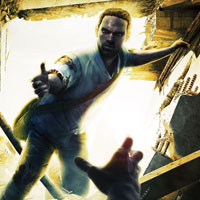Jeff Broadbent is a sonic artist whose passion for music and sound has found expression with blockbuster games such as Transformers: Dark of the Moon and the much-anticipated game I Am Alive. We talk with Jeff about the music of I Am Alive.
How did you get started scoring for games?
I had a great passion for both music and games from an early age. I started learning piano and saxophone at age 8, later studied music theory and composition as a teenager, and earned Bachelor’s and Master’s degrees in composition at Brigham Young University, as well as studying film scoring at UCLA. My goal after graduation was to begin scoring games. I started with smaller projects, including mobile games, as well as a lot of big action and trailer music for production music companies. When I got the chance to score Transformers: Dark of the Moon, it was a very exciting opportunity for me. Shortly thereafter I demoed for I Am Alive and was selected to score that project, which was also a great experience.
Describe your compositional process when working on I Am Alive. What were your aims?
My primary goals were to create a soundscape that would immerse the player in the post-apocalyptic world, as well as induce the key emotions of fear, desolation, and also hope that the main character of the game experiences. It was essential for the music to support the environment, in a non-obtrusive but engaging manner.
What were the biggest challenges working on the score?
The biggest challenge was very carefully selecting the instrumentation and sounds that were used in crafting the ambient score for the game. The music of I Am Alive relies primarily upon sound, texture, and rhythm (as opposed to the more traditional reliance upon melody and harmony). As such, the sonic colors themselves were crucial. It was important to create interesting sounds that would blur the lines between music and sound design.
Is there a particular element of the soundtrack you are fond of?
One particular music cue I am fond of is found in the final area of the game, where you find yourself in a crumbling pier park. For this area, the music uses interesting materials such as creaking metals, ambient bells, and tonal ambiences that blend well with the visual imagery. I’m also fond of the emotional music and themes that are used to convey the connection the protagonist has with the child Mei, whom he finds and protects.
Where you given complete creative control over the score?
I was given a lot of creative control when composing the music. There certainly was no dictate to make it sound like existing music scores – rather, because the game is very original, we wanted the music to be so as well. The audio director Zhang Lei gave me very helpful feedback as I composed, and helped guide me in the direction that would best support the game.
How do you structure your music for the video game medium?
In game music, interactive layers are often used that fade in and out of one another based on the gameplay. For example, in I Am Alive, we have an ambient exploration layer (for when the player is exploring, without combat), and a tension layer, that fades in on top of the exploration layer when the player approaches a dangerous situation. When engaged in combat, new music cues are used, with increased rhythm and intense sounds. Also, there are musical layers that play when you have low health or low stamina. So, each game is different, depending on the music implementation system.
What’s the creative process like for you?
When I compose music, before writing any notes, I like to have an overall idea of what I’d like to achieve. When an artist paints, he starts with a general sketch of the form, then tightens this form, and later adds the colors and shadings. Likewise, when I compose, I start with the macro elements such as form/arrangement, overall instrument choice, and harmonies/scales that will be used. I also will write out any main themes or motifs at this time. After that, I begin composing all the specific instrument parts, and finally tighten up the composition and mix with the details.






